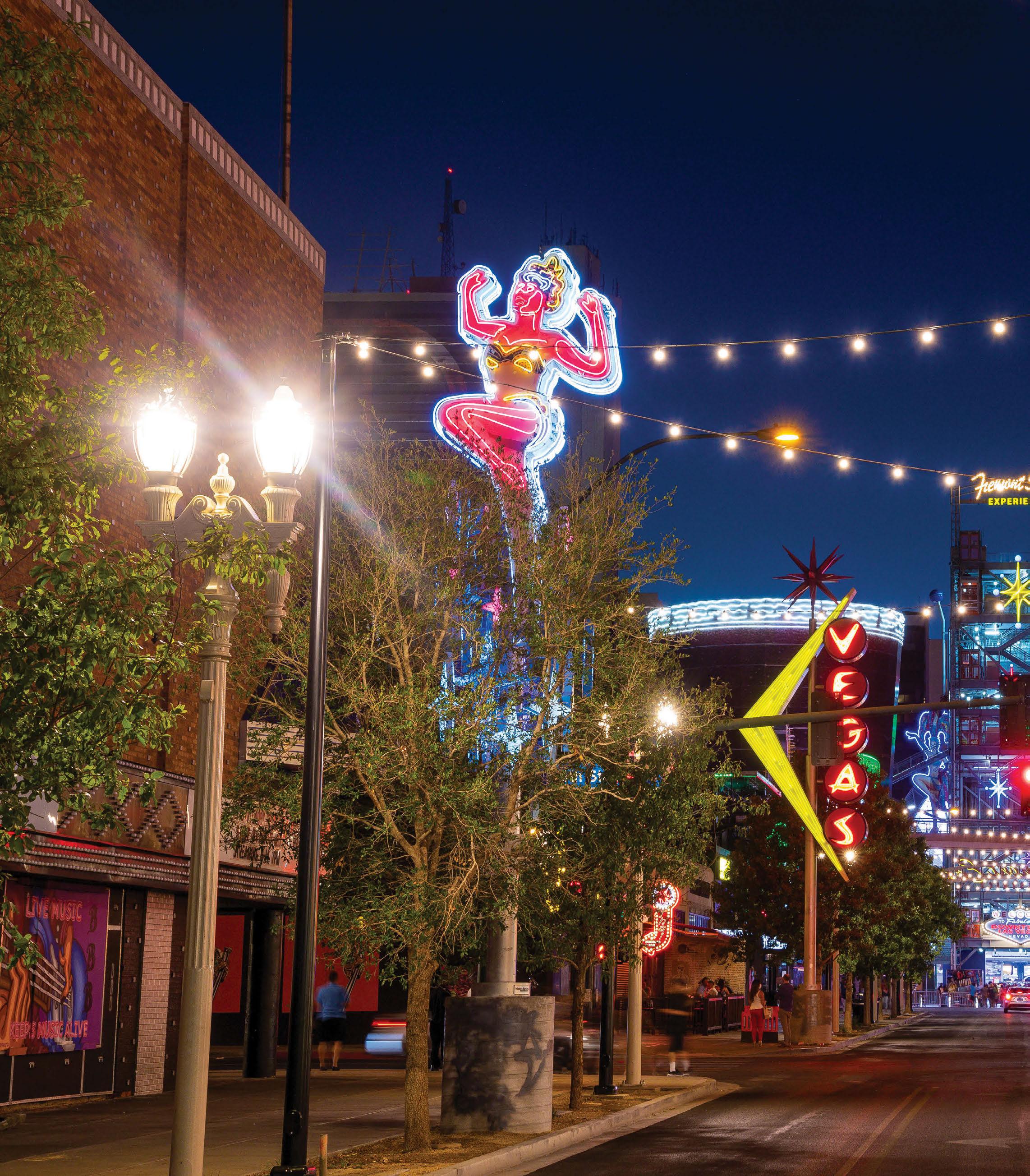
25 minute read
Cover story: Despite the pandemic, Downtown marches forward
Despite the pandemic and recession, the revitalization of Las Vegas’ city core pushes ahead
BY GEOFF CARTER W here can I get a beer around here? The Las Vegas Valley now has another solid answer to that question: That would be the Arts District, the still-vital cloister of galleries that’s fast becoming more of a beer district by volume. Consider: Able Baker Brewing, Beer District Brewing, Hop Nuts Brewing, CraftHaus Brewery, Three Sheets Craft Beer Bar and the just-opened Nevada Brew Works are located within a half-mile of one another, and they’ll soon be joined by HUDL Brewing Company, beer bar Silver Stamp and bottle shop/taproom Servehzah. And that’s not even counting such neighborhood favorites as ReBar, 18bin and Cornish Pasty, all of which have resoundingly deep beer lists. In Downtown Vegas, the pathway to success is rapidly becoming a canal of suds.
Under normal circumstances, that would be a story in itself. The wave of institutional knowledge flooding into Main Street is immense. Silver Stamp co-owner Rose Signor ran several wildly popular specialty beer events at Atomic Liquors. (“Beer history will be a big thing at Silver Stamp,” Signor promises.) The Nevada Brew Works crew trained at Chicago’s Siebel Institute of Technology, the oldest brewing school in the United States. And HUDL’s team boasts former Pizza Port assistant brewer Joe Couzzo as its brewmaster. When all these places are open and at full, post-coronavirus strength, somebody’ll need to wander the length of Main, pour all these wonderful beverages down their gullet and make real-time assessments. (So, y’know, watch this space.)
But that’s not the only thing going on. Downtown Las Vegas is experiencing an across-the-board development boom. Fremont Street will soon welcome Circa, the first new-from-theground-up hotel-casino constructed Downtown since 1980. (Again, watch this space.) The Downtown Grand has added a new tower with 629 additional rooms. Over in the Fremont East corridor, Commonwealth/Park on Fremont operator Corner Bar is adding four new properties to the Entertainment District: the recently opened tequila cave Lucky Day, 6,500-square-foot dance club Discopussy, ice cream parlor and rooftop nightclub We All Scream and intimate variety showroom Cheapshot. Developer J Dapper is now rehabilitating several properties in three different parts of Downtown: the Arts District (the former Western Cab building), the Huntridge neighborhood (the Huntridge Shopping Center and, soon, the historic Huntridge Theatre) and near Fremont East (the post office building at 201 Las Vegas Blvd. South). New Arts District restaurants—among them sushi bar Yu-Or-Mi, “coastal Mediterranean fusion” spot Taverna Costera, Golden Fog coffee bar and the Tex-Mexflavored Braeswood Barbecue—are opening soon. And there are several spots so new we’ve barely had a chance to visit, among them flower-strewn wine bar Cork and Thorn, the “uniquely European” Berlin Bar—another Arts District place with a killer beer list!— and The Garden, an LGBTQ bar and kitchen located within Art Square’s charming enclosed courtyard.
Yet all that good news is couched in uncertainty. COVID-19 has cut occupancies in half and put many thousands of locals out of work—the very people who usually pack Downtown’s bars and restaurants after a shift. Live entertainment, one of this town’s most durable support structures, now only happens on a small scale and at an impersonal distance. (Although, Majestic Repertory Theatre’s Troy Heard has discovered some ingenious ways to create entertainment within those limitations.) Tony Hsieh, the Zappos CEO who founded the Fremont-centric business development group Downtown Project, has retired from the online retailer and relocated to Utah, creating

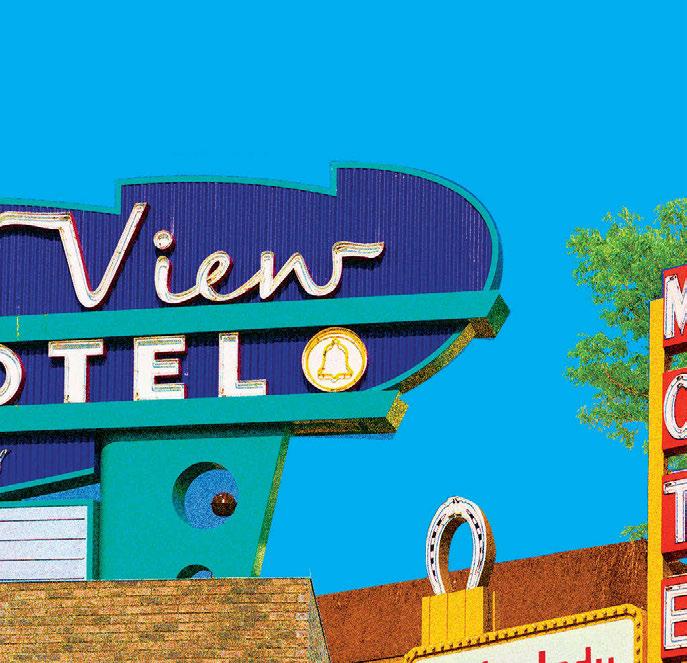


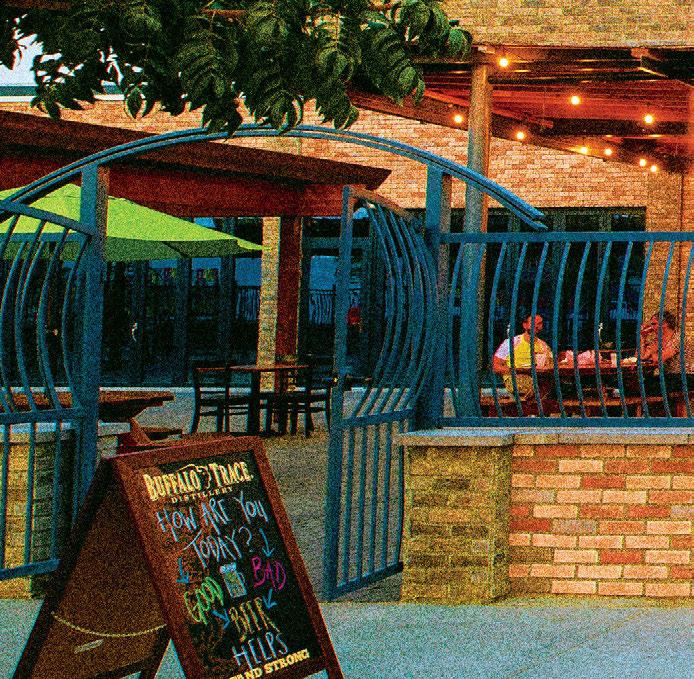

confusion on the ground about the fate of the properties within his portfolio. And there’s even more uneasiness about Vegas itself—anxiety over vanishing jobs and diminishing tourism dollars, and a sinking feeling that the virus has caused permanent damage to the city’s character.
But while there’s no predicting what could happen in the near future, undeniably exciting things are happening Downtown right now. Derelict buildings and potholed streets are being restored, beleaguered small businesses are nding their way amidst hardship, and visionary locals are still betting big on Downtown, readying new businesses to open. And residents, owners and sta ers have positive things to say about their neighbors.
“We are a resilient community,” says Cathy Brooks, proprietor of Fremont dog day care spot Hydrant Club. “We lift each other up.”
WHY BUILD DOWNTOWN?
“One of the things I love to do is just literally stand on Main Street and watch people parallel park,” Good Pie owner Vincent Rotolo says. “It brings me back, man, to when I was learning how to drive in New York City. My mom taught me how to parallel park.




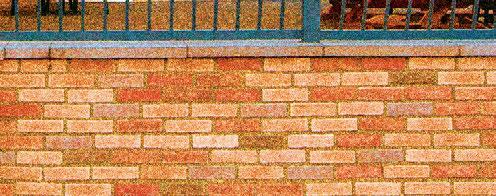
Just looking at parallel parking on the street reminds me of her. She passed away several years ago, so it’s nice to have those little things that remind you of family and home.”
Rotolo’s soon-to-open, 2,400-square-foot Good Pie location at 1212 South Main Street is already a beautiful space, tin-ceilinged and lled with hand-chosen New York ourishes: black-and-white “tenement” tile; a custom-cast manhole cover, emblazoned with the letters “NYC,” that will be embedded just outside the front door; a slice window with its own separate oven for reheating. The larger space will allow Rotolo to add items to the menu he couldn’t o er at his Pawn Plaza spot, like fried calamari. And he’s even worked out a hands-free ordering system, which can be accessed through mobile devices.
To fans of Good Pie’s existing Pawn Plaza location—whose function Rotolo intends to reassess once his Main Street version opens—that expanded kitchen represents mind-boggling avor possibilities. To beer-happy Main Street, that slice window will represent a tasty bulwark against daylong hangovers. But to Rotolo himself, this new space is an expression of his love for his adopted
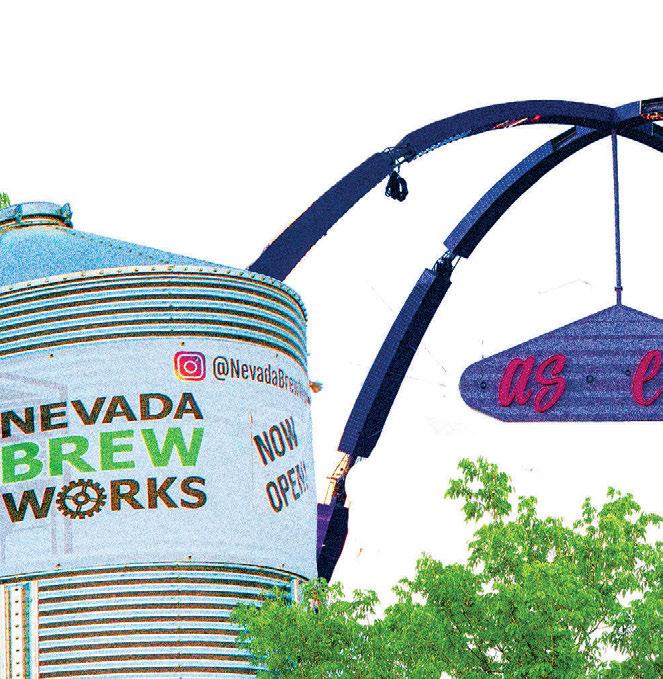
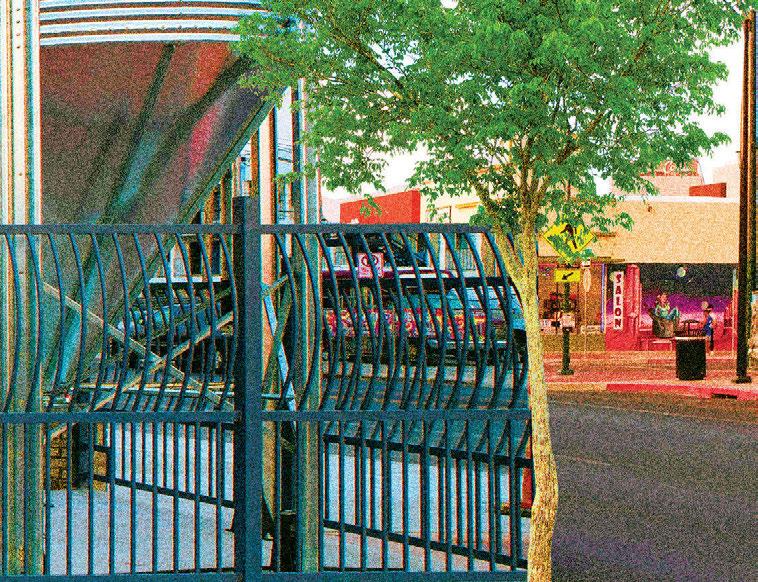
neighborhood.
“I grew up in a neighborhood where the neighborhood pizzeria was a special place for the community, and I want to provide something like that here,” Rotolo says. “When I was working on the Strip—I worked at Bellagio—I felt like I was able to have hospitality exchanges at a high level, but my life outside of work was unful- lled. Here, my work life and my life outside of work have come together in the community. I live and work in this neighborhood, and my customers are my neighbors, my friends.”
The feeling’s mutual down the street at Silver Stamp, which co-pro




prietors Rose Signor and Andrew Smith are steadily building out at 222 E. Imperial Avenue, formerly occupied in part by Curtis Joe Walker’s studio Photo Bang Bang. (PBB, along with several other Arts District galleries and businesses, has relocated to New Orleans Square in midtown’s Commercial Center District—another indicator of the strong bonds that form among Downtown business owners.) Signor and Smith are outdoorsy types with lots of camping and backpacking hours under their belts, and they promise an environment that will feel less like a bar and more like a cozy, 1970s-vintage rec room,
(Photo Illustration)
inspired by the small-town Americana they’ve taken in during their walkabouts.
“In the little desert towns,” Smith says, where they were inspired by community bars and restaurants that were, for all intents and purposes, “the only thing in town.” Silver Stamp will pay homage to those places with its vintage wood paneling; a general store-like bottle shop window; miniature bar rails set into pony walls, which should allow patrons to feel like they’re sitting at the main bar while maintaining distance (or, in a post-COVID world, to get a barlike seat when the main bar lls up); and its collection of vintage beer cans, signs and memorabilia. (“You know that beer arcade game ‘Tapper’?” Signor asks. “We’re trying to get our hands on that.”)
Signor and Smith have sunk a hefty chunk of their life savings into Silver Stamp, but to hear them talk, it all will prove worthwhile if they can build the kind of beer-loving community they knew at Atomic. (On a related note, the building they’re in belongs to Atomic owner Lance Johns, who’s opening a smaller “Atomic Tavern” just around the corner.)
“Already we’ve had people come in, see our [collection of vintage] cans and say, ‘Oh my God, I haven’t seen Billy Beer forever; I haven’t seen Schell’s,’” Smith says.
Fittingly, another Atomic veteran—chef Justin Kingsley Hall, who created the opening-day menu at the Kitchen at Atomic and once ran stellar pop-up dining spot SLO-Boy—is nding a new way to express himself in the Arts District. He’ll run the kitchen of Main Street Provisions, an all-new restaurant venture by former Del Frisco’s Double Eagle Steakhouse executive Kim Owens.
“I had been hearing about what Justin was doing at the Kitchen at Atomic, and his level of comfort food was just on point with what I was looking for,” Owens says. “I jokingly tell people that I stalked him for a year, but I did! I went to every event he did; I went to his restaurant when he was there, and when he wasn’t there. … What I really wanted to
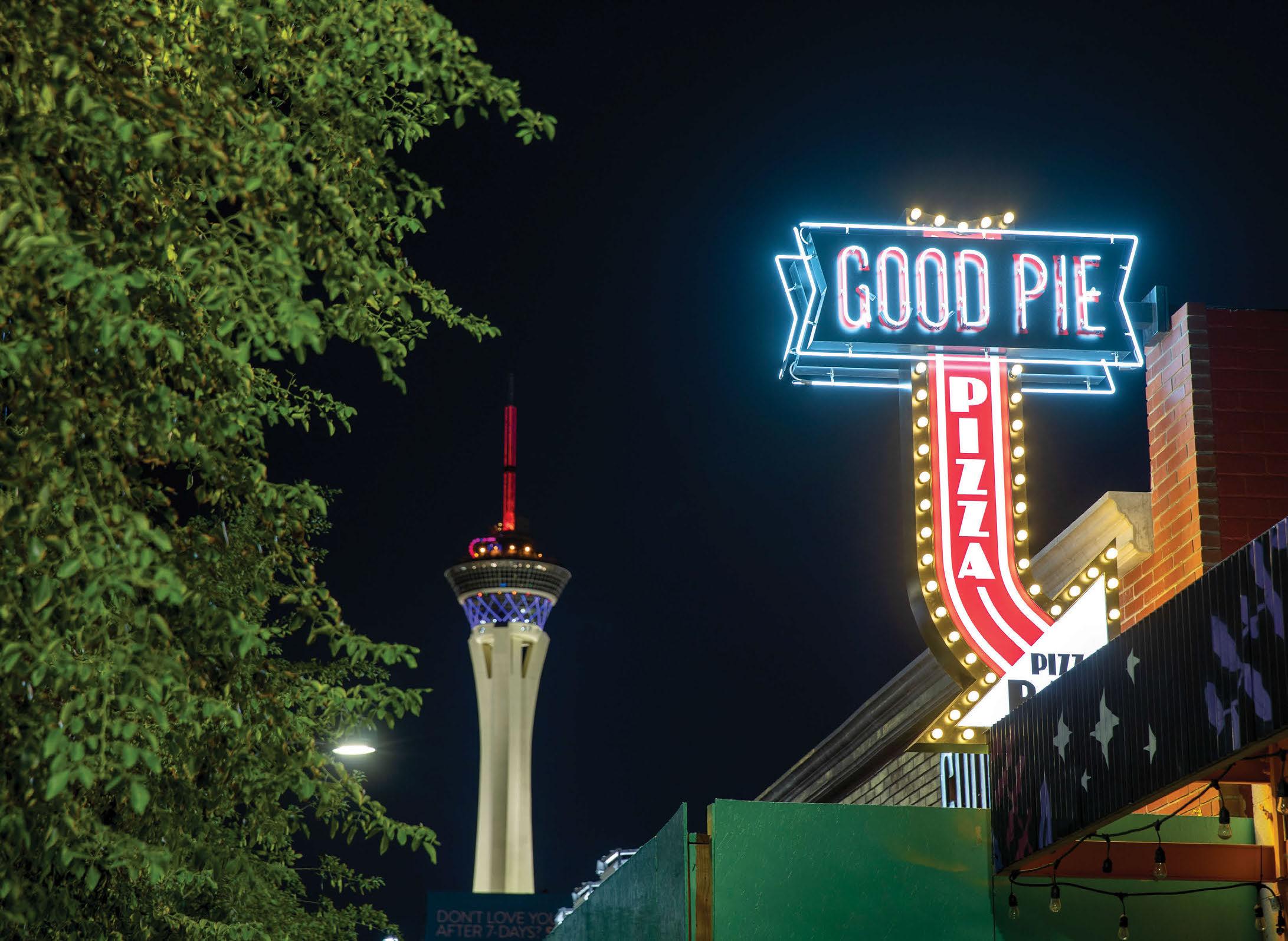
Good Pie’s new location (Steve Marcus/Staff)
find was a person who was not only a great chef and a great leader, but who cared about family and making things better for the people that worked for him. Justin fit the bill on all those fronts.”
Owens is building a space—directly next door to Good Pie—that should prove worthy of Hall’s prodigious talent. Like Rotolo, Owens is mixing old-school design elements (the ceiling support beams are artfully lit, a nice touch) with a high-tech bar and kitchen. And there’s a piece of equipment you’re unlikely to find elsewhere in the Valley: a charcoal-fired Fogarty oven, imported from the U.K., which the chef will undoubtedly put to good use.
But as is the case with her neighbors, Owens didn’t select this space for its utility or aesthetics. She chose it because her neighbors will be Esther’s Kitchen, ReBar, Garagiste Wine Room, Casa Don Juan, Velveteen Rabbit and, yes, Good Pie.
“The Arts District spoke to me,” she says. “So many great owner operators have chosen this area to develop their dreams and develop their concepts, and they work together as a unit. … Competition is competition. But what I love about this community is we all know that we succeed together and we fail together. Being successful together is the thing that will push everyone forward.”
It’s a sentiment that small business operators in every neighborhood could embrace, especially now, when there’s a real danger of local businesses being wiped out for good. (Keep your fingers crossed for Vick
–Good Pie owner Vincent Rotolo ie’s Diner, formerly Tiffany’s Café, recently pushed out of its longtime home in the White Cross building.) Who knows if it’s born of personal chemistry, good luck or even parallel parking? Whatever it is, it’s keeping Downtown alive and vital.
HANGING ON
Back in April, the Weekly spoke to various Downtown business owners about their long-term prospects under the cloud of COVID-19. Thus far, none of the businesses mentioned in that piece—ReBar, Velveteen Rabbit and Priscilla Fowler Fine Art—have been forced to shut down. But it remains a frightening possibility.
“I have a loan against my business, now,” ReBar’s Derek Stonebarger says. “The future is definitely uncertain, whereas before, we had every-
thing paid off; we were in the black for potentially the rest of our life. Now we have half the occupancy.”
Nevertheless, ReBar has recently reopened, serving a limited food menu like its neighbor Velveteen Rabbit. And in keeping with the times, ReBar will also feature a “wear your mask” warning sign listing various local and OSHA fines ReBar could incur if social distancing rules aren’t maintained. It’s tongue-in-cheek, but it still pains Stonebarger to deploy it.
“This is really hard,” he says. “We’re a customer service business. … [and] we have to change our customer service base. Where previously we worked for tips and would do anything a customer wanted, now we have to basically yell at them and police them. It’s a terrible time to be a business owner.”
The prospects for local bars that don’t serve food are even bleaker. Though Valley bars have received permission to reopen, their owners are clawing their way out of deep holes. They’ve lost months of income, taken on huge debt and shed valuable staffers, and they’re reopening at half-strength without much promise of state or federal aid. The plight of live entertainment venues, which largely remain shuttered with no end date in sight, is even more distressing.
The fate of Downtown music hub the Bunkhouse Saloon was already shadowed by the prospect of a lingering shutdown when its owner, Tony Hsieh, retired from Zappos and reportedly pulled stakes for Park City, Utah, taking a number of friends and staffers with him. (Hsieh did not respond to our request for comments.) Reps for Downtown Project, the Downtown Las Vegas redevelopment firm Hsieh founded, says very little will change in the wake of his departure. “Tony has always held the ‘visionary’ role … but a few years after inception, he employed many other decision-makers to dutifully run DTP companies, so there will be no significant impact resulting from his retirement from Zappos,” says DTP representative Megan Fazio. But locals have been left wondering what changes might arise from not having Hsieh’s boots on the ground.
Still, “the Downtown community is bigger than any one person,” Hydrant Club owner Cathy Brooks insists. “This may set us back, but I don’t know anyone Downtown who’s a quitter.”
Ronald Corso, owner of 11th Street Records and its adjoining National Southwestern Recording studio, agrees that the Downtown community itself may be best empowered to choose its next few steps.
“From my perspective, Tony Hsieh has had—on this corner, at least—the final say on who gets the opportunities,” Corso says. “Maybe this will make more room for locals who were already making the best of this town on their own to start doing that again. That’s my hope.”
Stonebarger says Hsieh “did great things by getting things started with a lot of buzz, a lot of press and some of his money,” but “this might’ve been perfect time for him to take off, you know? Only time will tell.”
In the meantime, the Bunkhouse, like so many other Downtown bars and venues, is on pause due to COVID-19. “As soon as the governor authorizes bars to reopen and when business levels get back to normal across the city, Downtown Project’s plans will resume based on demand,” Fazio says.
“Demand.” It’s a big ask, between the dual threat of a relentless virus and the economic ruin it has created. But where the Strip’s casinos have billionaires and banks to keep their
The Garden in the Arts District (Steve Marcus/Staff)

lights on, many of Downtown’s small businesses are being driven to choose between bad and worse options to stay alive. The least Las Vegans can do is find out how we can support them—by frequenting their business, buying gift certificates and spreading the word.
Just take it from Vincent Rotolo, who so naturally understands and explains what makes Downtown worthwhile, he could have been the guy who invented it.
“There are very few walkable streets in Las Vegas where you can park your car, have lunch, do some shopping, see some art and get a great beer,” he says. “And I think that whatever neighborhood or area you live in, we can all agree that quality is quality. And that’s what I’m drawn to here.”
THE WHOLE ENCHILADA
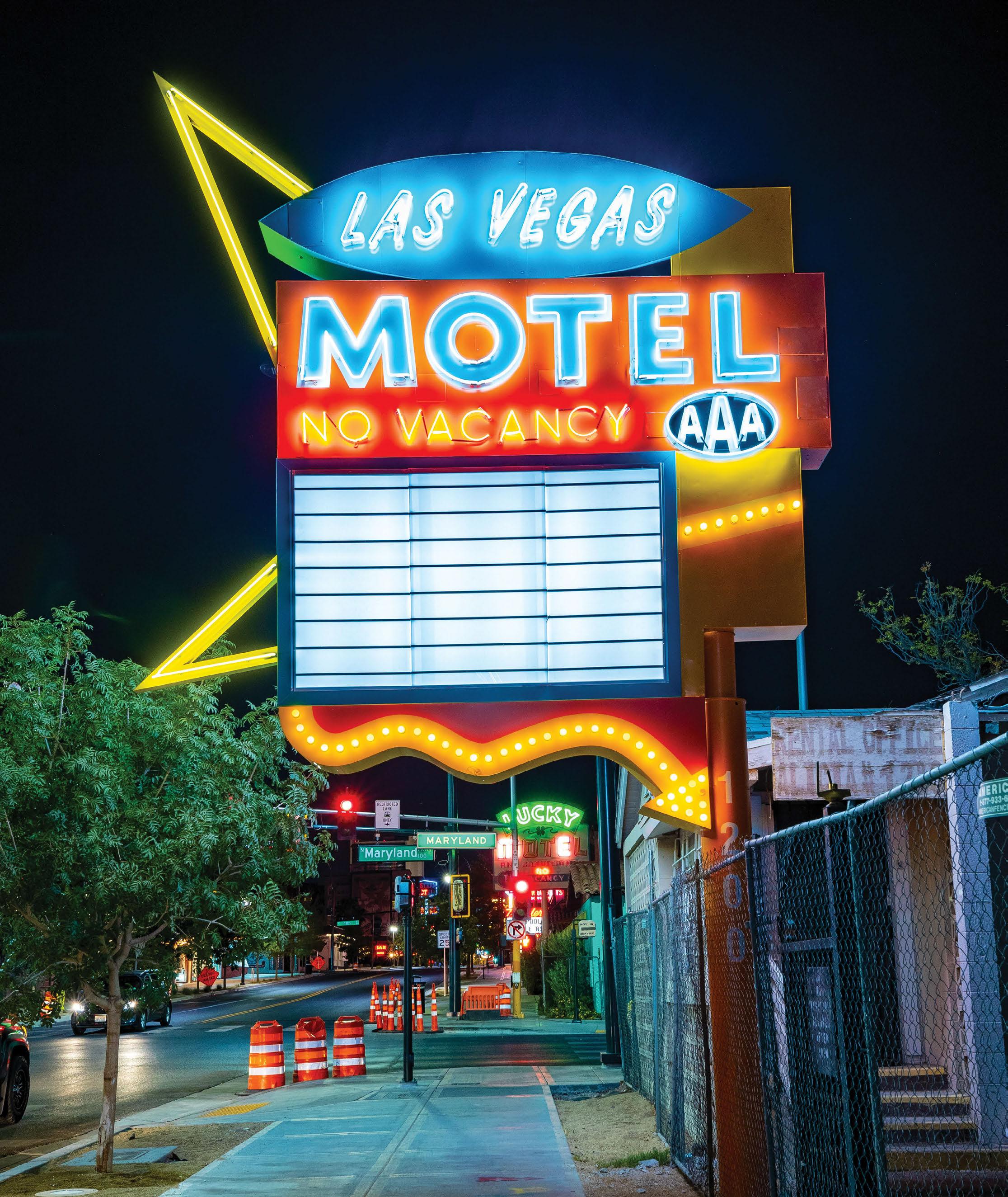
INSIDE THE PUBLIC-PRIVATE PARTNERSHIP PUTTING A SHINE BACK ON DOWNTOWN
BY GEOFF CARTER Y ears ago, when the rehabilitation of Las Vegas’ city core began in earnest, even the most optimistic of civic boosters would tell you that a lot of hands, both public and private, needed to join together to make Downtown happen. That sentiment holds true now more than ever: For every success like Main Street, where years of City-sponsored infrastructure work and small business investment are nicely coalescing, there are other areas of Downtown in need of compounded improvements: new infrastructure upgrades, private investment, improved streetscapes, green space, protections for historic buildings and more.
Enter Project Enchilada, and Brad Jerbic. Project Enchilada is an initiative by the City of Las Vegas and a number of private stakeholders—most notably Downtown Project, which owns a number of shuttered Fremont Street motels—to revitalize Downtown’s challenged areas. And Jerbic, the former, longtime City Attorney for Las Vegas, is Project Enchilada’s coordinator, a position for which he receives no pay. His compensation is personal: His family moved to town in 1962, when he was 4 years old. “I spent my first two nights in Las Vegas at a motel on Sixth Street,” Jerbic says. “I grew up seeing a vibrant, thriving Downtown. To think of that coming back is enormously pleasing.”
Jerbic jumped into the project as a way to process the tragedy of the October 1 shootings, in which he lost a good friend. “I thought it would be fun to get involved in a project that looked at everything—not just a piece or an individual development, like a Neonopolis, but something that would actually be the whole enchilada.” A giant swath of Downtown was marked for improvement—east from I-15 to Eastern Avenue and north from Charleston Boulevard to US 95, plus the Arts District and the Huntridge neighborhood. “We’re not going to have a healthy and vibrant Downtown unless we start putting a lot of pieces together,” Jerbic says.
The first phase of the project is well underway. It includes the rescue and rehabilitation of the historic Huntridge Theater; developer J Dapper, who recently revitalized the adjacent Huntridge Shopping Center, should close escrow on the 77-year-old property on December 28, Jerbic says. (Meanwhile, Dapper continues to work on Huntridge Center, which is getting a new grocery store, and he’s refining plans to transform nearby Huntridge Circle Park into a sculpture garden and kids’ play area.) The other aspect of Phase 1 is a refresh of Fremont Street from Las Vegas Boulevard to 14th Street, which includes a blanket of deciduous shade trees and the surprising return of a design element plucked from Downtown’s past.
“When we started, we brought in some people from out of state to advise us,” Jerbic says. One of them was a Philadelphia-based architecture firm called Civic
(Wade Vandervort/Staff)

Visions, whose principals, a married couple—“she’s an architect, he’s a cultural historian,” Jerbic notes— specialize in mid-century modern architecture. They showed Jerbic photos of ornate iron streetlights, installed along Fremont Street in 1929 and taken down in the mid-1940s. “I had never seen a picture of them before, knew nothing about them, but suddenly it became almost an obsession to try and re-create them,” Jerbic says. “We actually found one of the original poles in West Las Vegas, and the original headpiece in Hancock Park in LA. So we were able to send the dimensions—in fact, we sent the headpiece itself—to [a fabricator in] Pennsylvania.”
The first batch of re-created streetlights, lit with LED bulbs, was recently installed on Fremont Street, from Las Vegas Boulevard to Eighth Street. And while they might take a little getting used to—they’re built to be noticed, which most contemporary streetlights are not—they bring warmth and personality to the streetscape. Eventually, these streetlights and shade trees will cover 12 square blocks of Downtown, enhancing its walkability and filling in what Jerbic calls the area’s “missing teeth.”
“You’ll walk one block and there’s something, then you walk a little bit farther and there’s nothing. That’s a missing tooth,” Jerbic says. Empty lots, boarded-up motels and dead neon signs are anathema to Jerbic, unwanted vacancies in Downtown’s tentative smile. He likes the businesses of outer Fremont, particularly Downtown Project’s Ferguson Motel revival, but they look lonely to him. “How do you fill in the gap between Sixth Street and 11th Street?,” he asks. “And then what do you do when you get past that?”
The answer to that question has produced some of the most striking elements of Downtown’s rebirth. Project Enchilada is restoring Fremont Street’s dilapidated neon motel signs to their original condition, using a $750,000 grant from the Las Vegas Centennial Commission. (It’s not taxpayer money; the funds come from a fee attached to the yearly registration of a limited-edition license plate.) The Star View Motel, Las Vegas Motel, Fremont Motel and Lucky Motel signs have all been repainted and re-lit, and they look like a million bucks. The Gables, Valley and Sky Ranch Motel signs will soon follow. And in a victory for neighborhood integrity, those signs will stay exactly where they are, even if their host properties become something else.
“All those colors that you see on those buildings … we would literally get out there in the middle of summer with a knife and razor blade and scrape the buildings, scrape the signs to get down to their original colors,” Jerbic says. “And once you get the original color, Dunn-Edwards makes a paint that is very long-lasting in our desert climate. … These are like the colors of cars that were coming out of Detroit in the 1950s. There’s a real connection here between what these buildings look like, what these signs look like and what was going on in America at that time. It’s just funky as all hell.”
Other cooks are tending to other ingredients of the Enchilada. The City of Las Vegas is taking care of updating the sidewalks, roads and utilities (see Page 18), while Downtown Project has been tasked with fixing up the exteriors of the boarded-up motels that it owns—new paint, landscaping, resurfaced parking lots and more. The eventual use of those properties remains a question mark.
“There isn’t a decided-upon plan for what the interiors will be,” Jerbic says. “But we have looked around the country at old motels that have actually reopened and they’re on fire; they’re very, very popular. But they could also do a rehab like the Fergusons: remove some walls and turn it into retail and restaurants.” And there’s another possibility: “We’ve had developers approach us that are interested in working with Downtown Project to develop multifamily housing.”
Jerbic has other dream projects in mind: the Mayfair neighborhood, the tiny pink building at the corner of corner of Fremont and Eighth Streets (“it’s the oldest surviving gas station in Nevada”), those motel signs that have already been taken down (if there’s no property to match them to, they may go in the median of Las Vegas Boulevard, or in front of the so-called Llama Lot) and the possibility of a UNLV satellite campus in the neighborhood. And Jerbic will continue to see it through, even if it means filling an indeterminate number of his post-retirement days with pro bono urban planning work.
“I’ve got a new business card: One side says ‘Project Enchilada’ and the other ‘Brad Jerbic, Volunteer,” he says, laughing. “As far as the amount of hours I’m putting into this, pick the day and I’ll tell you how much. Sometimes I’ll be up all night long on the internet, finding some detail that I missed … and some days I’ll just be kicking back, scratching my belly, watching TV. But this is just a wildly cool time to be Downtown.”
STREET LIFE Downtown is experiencing tra nsformation from the roads up
BY GEOFF CARTER M ike Janssen is director of Public Works for the City of Las Vegas. That’s his job. But recently, in the course of one of the City’s current works projects—a three-year, $109 million refresh of Las Vegas Boulevard between Sahara and Stewart avenues, which includes remakes of several nearby streets, including Casino Center and Imperial—he donned an unexpected hat. When an excavation crew working Charleston Boulevard and Gass Avenue made a strange discovery, Janssen became an archaeologist.
“When we do a project, the Water District and [Southwest Gas] say, ‘Hey, here’s an opportunity for us to put in new lines, and the city will take care of the paving.’ It’s a win-win for all of us,” Janssen says. The Gass and Charleston crew found a line that wasn’t on their map of existing utilities, which doesn’t surprise Janssen: “Downtown has some really old streets, where we don’t have good records.”
The crew gingerly dug out the unknown utility by hand. It was an abandoned water line made from—of all things—California redwood. “We got into the Water District archives: This water line was installed all over Downtown in 1908. It was abandoned in 1956, after they put in cast-iron water mains. And here we are now, removing all the cast-iron and replacing it with a sort of polyethylene plastic line.”
While that 112-year-old water line is the oldest thing Janssen has found buried beneath Downtown’s streets so far, it’s not the only antique. The water lines along Downtown’s stretch of Las Vegas Boulevard are 65 years old. Its traffic signals were installed beginning in 1965; the most recent was added in 1990. And the sewer, a piece of infrastructure you really don’t want to outlast its usefulness, was built in 1942. “We’re completely replacing it, upsizing it,” Janssen says. “I can’t imagine that my predecessor, way back in the 1940s, ever thought we’d become the 25th-largest city in the country.”
All of that, plus smart traffic signals that can communicate with vehicles, dedicated right-turn lanes and a welcome full pavement replacement, will equip Las Vegas Boulevard to deal with Downtown’s increasing traffic. But the good news isn’t exclusive to drivers.
“We’re also adding lot of what we call ‘complete street’ elements,” Janssen says. “In the old days we would do a roadwork project, and it was just for the cars. We took care of the vehicles, but in the last couple of years, we’ve taken on the perspective of all the road users.”
Accordingly, the plans for Las Vegas Boulevard and many of its intersecting streets call for new streetlights, dedicated bike lanes and sidewalks 10 to 15 feet wide, lined with shade trees. “We’re getting large trees, 48-inch, 60-inch box trees; when you plant them, they immediately provide that street canopy,” Janssen says. “Nobody has time to wait for shade.”
If you want to get an idea of what that will feel like, just head down to the Fremont East district, where work continues, or to the recently completed stretch of Third Street that runs from Charleston to Garces. Newly planted trees provide a solid blanket of shade. (The trade-off is that they partially obscure some scenic façades, in particular that of the El Cortez; hopefully that won’t be an issue after a few years of growth.) And the sidewalks are enormous, ready for street-side drinking and dining. The revamped Third Street even twists and turns a bit, adding much-needed variety to Downtown walks and bike rides. The streets simply feel better, both on foot and from behind the wheel.
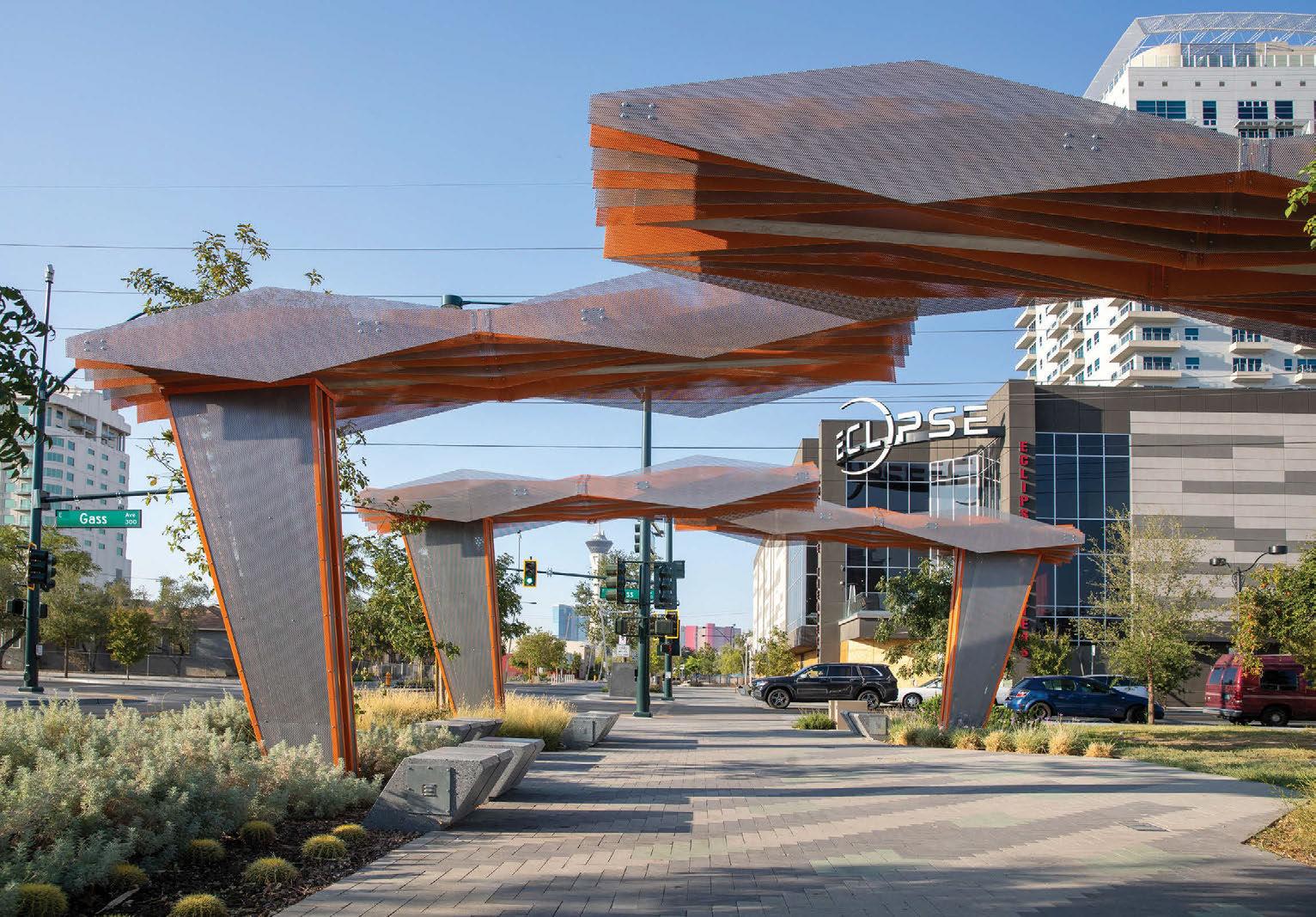
Sidewalk improvements on Third Street between Charleston and Garces. (Steve Marcus/ Staff)
The placemaking aspect of this roadwork— giving Downtown a markedly different look than the South Strip or Water Street—perhaps has no more visible expression than the two projects being constructed at Las Vegas Boulevard and Sahara. The first, an 80-foot, roadway straddling Downtown gateway arch located adjacent to the Strat, is nearly complete; you can drive under it now. It’s an impressive structure, one with a deep old-Vegas connection: It bears more than a passing resemblance to the LAX Theme Building, which was designed in part by architect Paul Revere Williams—designer of the shell-like lobby of the former La Concha Motel, now functioning as the visitor’s center for the Neon Museum.
But the other project, which is several years out, will be the true Downtown border for northbound Strip drivers: an oval-shaped pedestrian bridge connecting all four corners of Sahara and Las Vegas Boulevard in one elegant loop. At least two different support concepts for the bridge—a four-pillar suspension model, and another tall arch— are being considered, but the consistent idea is to make the bridge eye-catching and efficient. That’s the throughline of all of the City’s current Downtown road projects.
“It wouldn’t be possible if it wasn’t for the voters,” Janssen says, in reference to Las Vegas’ overwhelming support of a fuel tax index that supports Valley road project like these. “I have to thank our voters who have said, ‘We want good roads. We don’t want roads with potholes. We want roads with good lighting, roads with traffic signals where they’re needed.’ We’re able to do all that, because our community has embraced investing in transportation.”





